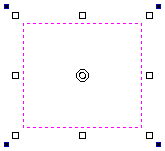Rotate

For precise control of the rotation, or to use a point other than the selection's center as the rotation center, you can open the rotation form from the Drawing Tab.
Selected items in the 2D View can be rotated to a new orientation using this tool. The rotation options form can be activated from the tool icon on the Drawing Tab. Alternatively you can use the interactive transform mode (where the form is not required) directly from the 2D View.
With this form open the additional Pivot Point handle is available (two concentric circles initially positioned at the center of your selection) for you to click and drag in the 2D View. The Pivot Point (around which the selection will be rotated) responds to the currently enabled snapping options to help you to position it precisely on significant locations within your artwork. Hold down the Shift key to temporarily disable snapping while you drag the Pivot Point.

Pivot Point
On the form there are also six radio button options for snapping the rotation Pivot Point to the selection itself or to a precise position. The first five options allow you to snap to the corners and center of your selection.
Use Coordinates
The X and Y edit boxes allows you to precisely specify the position of the Pivot Point. This is also the option that will be selected by default if you drag the pivot point using your mouse directly in the 2D View.
Type of Rotation and Angle
This controls what the angle value does.
- Relative will simply rotate the object by the given angle. For example, you can enter a small angle, and then rotate multiple times to nudge the object a little bit at a time. A positive angle results in a counter clockwise rotation. A negative angle results in a clockwise rotation.
- Absolute will set the rotation of the object to the given angle. For example, setting a zero angle here will reset the rotation of the object back to its original orientation (as long as the rotation hasn't been baked).
Keep in mind that when rotating an object, it's rotation is maintained so that you can restore the rotation or scale along its original axes later on if required.
Interactive Rotation
Generally the most convenient way to rotate an object in the 2D View is to use interactive transform. This mode is initiated by clicking the selected object twice with the cursor. The process is:
- Select the object by clicking on it in the 2D View (or multiply select objects using box selection or by shift-clicking on them).
- Click the selection a second time to activate the interactive options rotation handles on the selection box.
- Click and drag on the blue handles (solid squares) at the far corners of the selection to rotate it.
Note
Holding down an Alt key when dragging to rotate the object snaps to angular rotation steps of 15° increments.